Today, I want to show you how modern patio enclosures can help you save 25% of your budget. It doesn’t matter whether you intend to buy a new pool enclosure, or go about your daily routine (maintaining and operating a swimming pool).
By the end of this article, you’ll appreciate why buying a pool enclosure for $2,999 is more rewarding than a pool cover at $250.
Here are 13 understated values of pool enclosures most manufacturers rarely talk about:
1. All Pool Enclosures Come With a 15 Year Warranty Period
You’ll find that all swimming pool enclosures come with a 15 year warranty. Obviously, this is a clear indication that the swimming pool enclosure will serve you for more than 15 years.

Excelite polycarbonate enclosure with a 15 year warranty.
In fact, a high quality pool enclosure will last for about 25 years. You can’t compare this to pool covers that come with a 2 or 3 year warranty.
Normally, this warranty covers polycarbonate against yellowing. Yellowing is a common phenomenon when polycarbonate sheets are used outdoors.
It is a first indication of polycarbonate degradation. That is, a change in its physical and chemical properties.

A polycarbonate sheet with anti-ultraviolet radiation coating
A high quality solid polycarbonate sheet will not change color within this period. They have an anti-ultraviolet radiation layer.
This layer enhances its weathering resistance properties.
Again, the warranty covers the extruded aluminum from rust or breakage during the 15 years. It may also cover other aluminum surface treatments.
Within the 15 years, the swimming pool enclosure manufacturing company can replace it for you. That is, in case of failure or problems you’ve encountered may be due to their manufacturing process.
Always follow the recommended installation, cleaning and maintenance procedures.
Definitely, with this alone, you’re likely to save over 25% after installing polycarbonate swimming pool enclosure.
2. Solid Polycarbonate and Extruded Aluminum are Easy to Clean and Maintain
Cleaning patio enclosure is simple, easy and cheap. You don’t need expensive cleaning detergents or machines to do this.
The two materials (aluminum and polycarbonate sheets) do not react with most organic and inorganic compounds.
Here are Great Tips on Cleaning Pool Screen Enclosures.
All you need is water and cleaning detergent. You can use soap as a detergent.

Cleaning patio enclosure make it attractive and hygienic
With these, the procedure is very simple:
- Inspect the patio enclosure to identify types of stains
- Rinse the entire enclosure with clean water
- Using a sponge and mild soap, gently scrub the entire surface of the enclosure
- Rinse with clean water and let it dry before using the enclosure
This is a simple DIY process. So, you don’t have to hire a cleaning company.
Remember, in the case of solar or winter pool covers, you may require special machines to clean their surface. This will only add more expenses.
In short, a simple and an easy cleaning process will help you cut on costs.
3. Patio Enclosures are Easy to Install; No Need to Hire an Expert
With a swimming pool enclosure installation guide, you can accomplish the task within 3 to 7 days. Maybe, you can hire one person to help you during the process.

A technician installing a patio enclosure
Installing winter or solar pool covers is easier compared to the patio enclosures. Again, you may hire another person to help with the installation process.
But, why do I say that installing a patio enclosure is still cheap?
When you have a pool cover, you’ll be forced to remove it depending on the weather condition. Of course, this is not only a tiresome process, but also costly.
Remember, you’ll have to hire someone to assist you during this process. On the other hand, installing a patio enclosure is a one-time process.
Therefore, you don’t have to hire an assistant unless you plan to remodel or construct a new enclosure.
4. Simple Design thus, Affordable to Most Homeowners
A standard swimming pool enclosure cost is $2,999. I am sure this is quite affordable considering that the polycarbonate patio enclosures will serve you for over two decades.
Surprisingly, a number of swimming pool enclosure manufacturing companies have reduced their retail prices by over 33%. You can also get a high quality pool enclosure at affordable prices.
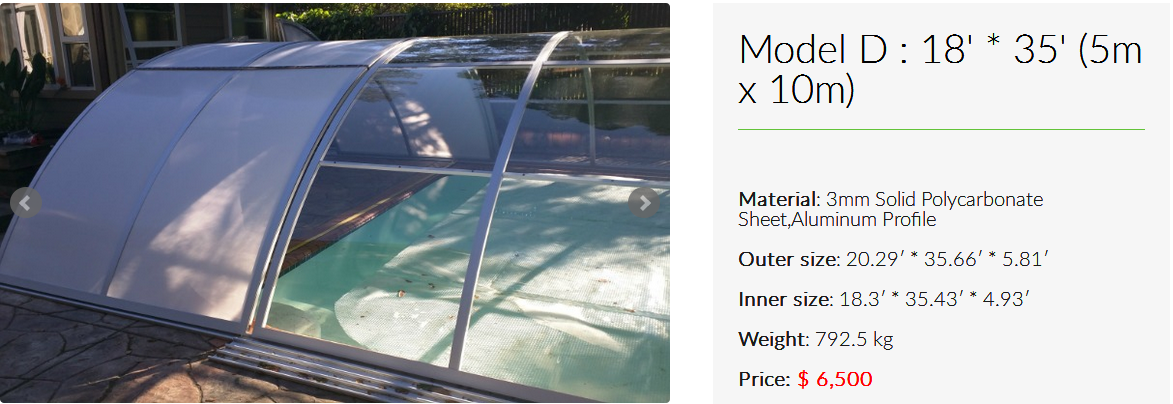
Here is an Excelite swimming pool enclosure cover that retails at over 33% OFF the market price.
Quite a number of these patio enclosures are available in standard designs. Again, you’re likely to save ore bucks here.
This doesn’t imply that you can’t customize one to your unique requirements. This is possible, although you’ll have to pay more for this.
Alternatively, you can upgrade or remodel an old pool enclosure by incorporating various enhancements that will make it look modern. That is, you may include chairs, beds, flower vases, or LED lighting systems.
Remember, upgrading an existing pool enclosure is cheaper than buying a new one.
5. Enclosure Guarantee Safety that Would Otherwise be Costly
In case you own a swimming pool, safety and security must be a priority. This is the main reason why all pool enclosures are equipped with self-latching door locking mechanism.
Moreover, they are constructed from solid polycarbonate sheets and extruded aluminum due to their strength. That is, your patio enclosure will not collapse when subjected to heavy load or strong wind.
Therefore, all swimmers will be safe at all times.
For better swimming pool safety standards, governments/states have a number of by-laws. These help to enforce these safety rules and regulations.
Also, pool enclosures are virtually unbreakable. This provides better security since, unauthorized persons cannot access your swimming pool without permission.
Failure to observe any of the safety and security standards can be costly. Without an enclosure, anyone can access the pool increasing chances of drowning.

A child drowns in a swimming pool without an enclosure
At the moment, drowning is one of the leading causes of deaths among kids between the age of 1 and 8 years old.
To avoid this agony and loss, you need to install a patio enclosure, which is one of the trusted swimming pool safety equipment.
6. Retractable/Telescopic Enclosures are Easy and Simple to Operate
The good thing about retractable pool enclosures is that, you can decide to have an indoor or outdoor environment depending on the position of your cover.
Retractable patio enclosures are such that you can open or close them by applying a slight force at one of the covers. This makes your pool enclosure cover to slide seamlessly on the rail tracking system.
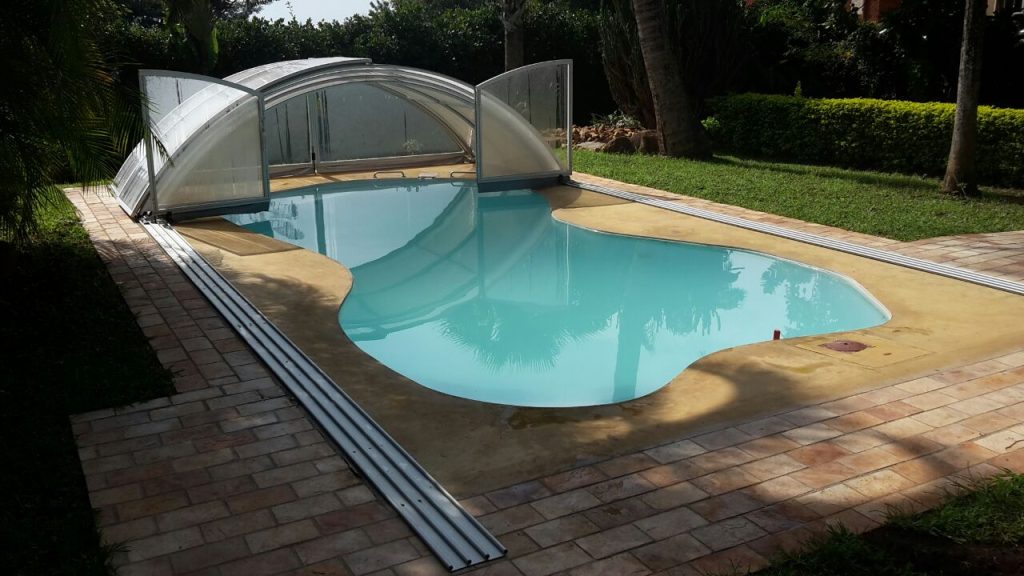
Excelite’s retractable pool enclosures. It creates an indoor/outdoor environment depending on the position of the enclosure
It can take less than a minute to completely open or close the enclosure. Therefore, you don’t need to hire a swimming pool assistance.
One person can open and close the pool enclosure, unlike the winter or solar pool covers.
For winter or solar swimming pool covers, you’ll need an assistant to help you secure it on the pool deck, especially if you have a large swimming pool.
This will reduce the cost of operating a commercial swimming pool.
7. Patio Enclosures Will Lower Your Monthly Insurance Premiums
Normally, the insurance premiums you pay for a home will depend on the degree of risk.
As I had mentioned earlier, a swimming pool without a cover is not safe. In fact, there are companies that do not include such pools in an insurance policy.
If they have to, then the premium will be very high.
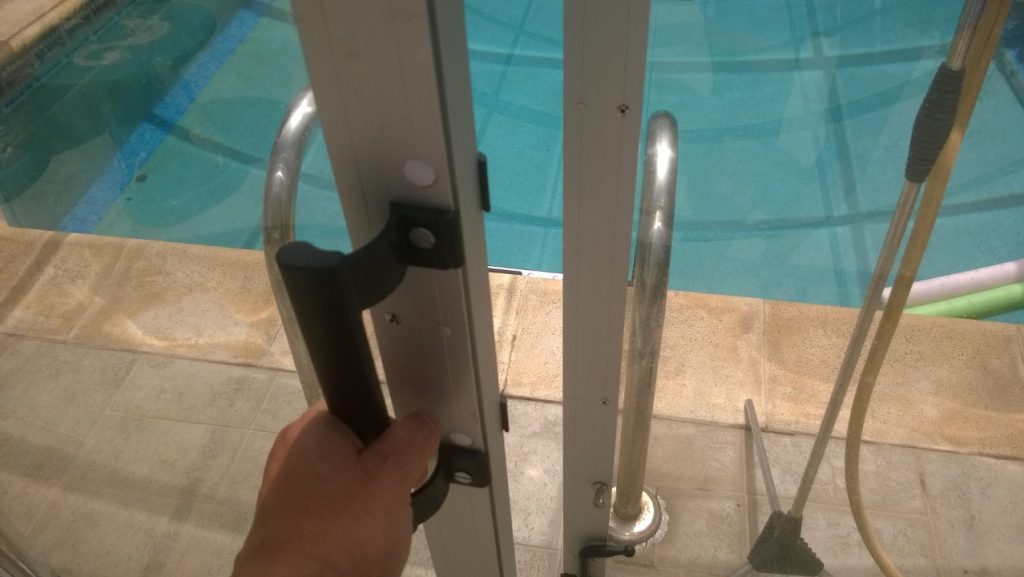
A lockable door provides better security. Therefore, no one can access the pool without your permission.
The only way to reduce your monthly insurance is to install a polycarbonate swimming pool enclosure. This is because it will eliminate all possible risks such as drowning or the pool getting messed up during winter.
8. For Realtors, Patio Enclosures Increase Property Value
A stylish swimming pool enclosure design will make your home more beautiful. This actually one of the reasons most people opt for a pool enclosure as opposed to covers.

A swimming pool solar cover
You can compare the above swimming pool cover to a pool enclosure below. Which one looks attractive?

The pool enclosure above has completely transformed the outdoor space of this home.
Definitely, by installing a high quality patio enclosure, you’ll transform the appearance and aesthetic value of your home. As a result, you’ll increase the value of that property.
This is a noble idea for realtors who sell homes for a profit. It is a simple and easy way to increase a home value by more than 17%.
Remember, buyers tend to focus more on value added equipment and accessories that can make their lives comfortable. It is one equipment every swimming enthusiast will desire to have since it will extend the swimming season.
9. Block All Harmful Ultraviolet Radiations hence, Safe
Outdoor swimming pools are exposed to the extreme and fluctuating ultraviolet radiations.
First, ultraviolet radiation has the following key effects:
- Speed up growth of some algae making it difficult to clean the pool. They may also cause some diseases.
- Facilitate the decomposition of swimming pool chemicals causing chemical imbalance.
- Prolonged exposure to UV radiations may cause sunburn
To avoid all these, you need to install polycarbonate patio enclosures. They filter all the harmful ultraviolet radiations
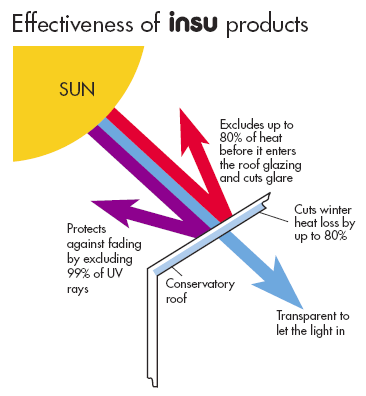
The image illustrates some of the key benefits of polycarbonate swimming pool enclosure
Also, you may opt for the tinted swimming pool covers. They increase privacy and reduce the intensity of light reaching the pool surface.
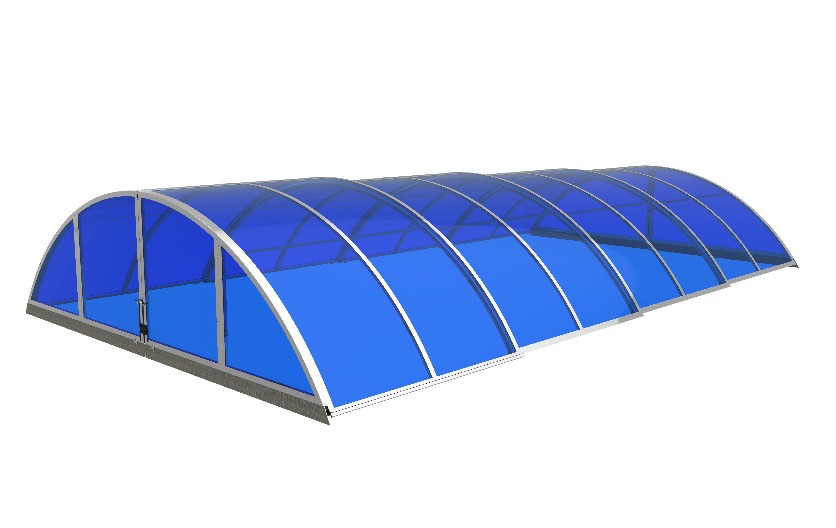
A tinted polycarbonate swimming pool enclosure increases privacy
In short, this will make you safe, add privacy and reduce the cost of operating a swimming pool.
10. You Don’t Have to Clean the Pool Everyday
Cleaning swimming pool enclosure is a tedious and expensive process. This is even worse if you don’t have a patio enclosure.
For a commercial swimming pool, you’ll have to hire an assistant to help you in the cleaning process. Moreover, you’ll require other cleaning accessories.
A patio enclosure will isolate the pool from the external environment, thereby protecting it from dust or dirt. The good thing is that you don’t have to clean your pool every time.
I am sure, you’ll save a reasonable amount of money – maybe more than 25% of your budget.
11. Patio Enclosures Reduce Heat and Water Loss; Reducing Operational Costs
When a swimming pool is exposed to the external environment, you’re likely to incur high operational costs.
First, the wind blowing over the pool will increase the rate of water loss through evaporation. As a result, you’ll be forced to refill the pool, which will increase cost of operating a swimming pool.
Moreover, the evaporation will also cause swimming pool chemical imbalance. Therefore, you’ll have to treat your pool to restore its PH.

A man checking swimming pool water PH
A swimming pool without a patio enclosure tend to lose a lot of heat energy. As a result, you’ll be forced to heat the swimming pool all the time, increasing energy bills.
With a patio enclosure, you’ll save on all these operational expenses. This is because the patio will reduce heat loss and evaporation.
12. Pool Enclosures Extend Swimming Season, hence Profitable for Commercial Pools
You’ll only profit from your swimming pool when people use it during both summer and winter. With a high profile pool enclosure, people will swim even when the cover is closed.

A high profile pool enclosure which is spacious
The patio enclosure will provide a “shelter” that will protect you from the cold weather condition during snow. Again, it will protect you from the scorching heat from the sun.
13. All Patio Enclosures Offer Unmatched Convenience and Flexibility
Again, the fact that you can have an indoor or an outdoor environment depending on the position of the enclosure; provides unmatched convenience and flexibility.
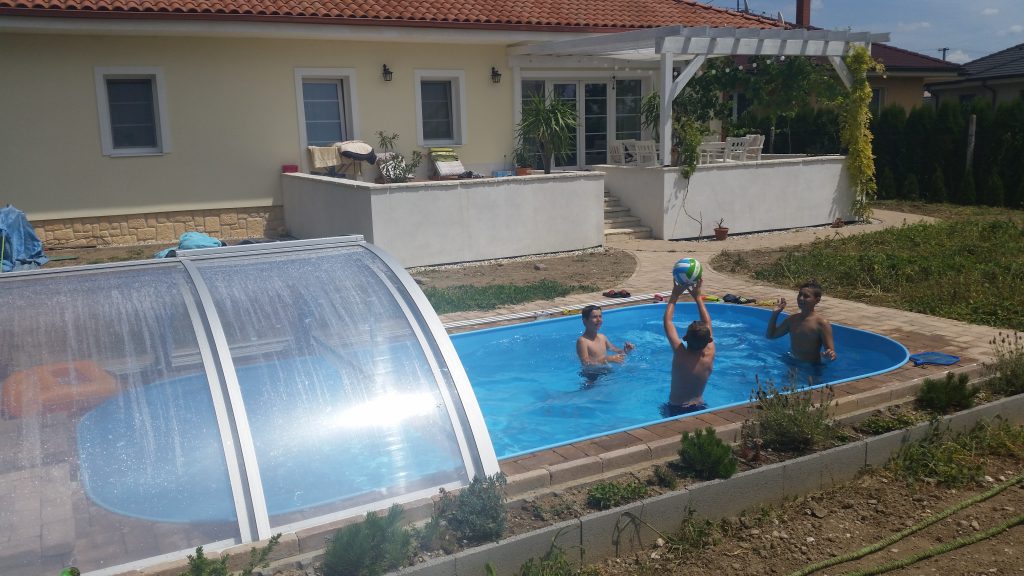
A retractable pool enclosure provides an indoor and outdoor environment
This alone will save you from the expensive proves of changing swimming pool covers.
Apart from these solid polycarbonate sheets and extruded aluminum is environmentally friendly. They don’t emit harmful radiation, fumes or smell.
It is for this reason that patio enclosures are considered safe and have become popular among many applications.
Conclusion
As you can see, you can still save a lot of money by installing a patio enclosure. All you need is a high quality enclosure manufactured by a reputable company.
